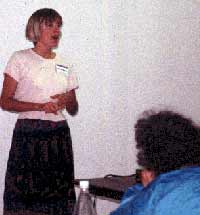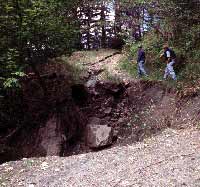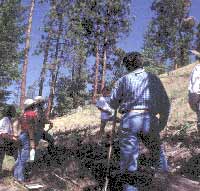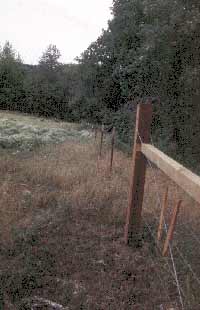
|
|

|
|
In This Issue:
Revegetation Workshop Informs Resource Conservation ProfessionalsOn June 6th the RCD presented a one-day workshop on the revegetation techniques utilized in its restoration work in the Grass Valley Creek watershed. The workshop was directed towards natural resource professionals who are involved in restoration projects, with interested participants coming from such agencies as the US Forest Service, AmeriCorps, California Department of Forestry, and the National Park Service. Several private consultants also participated. The workshop consisted of a morning lecture session where basic revegetation techniques were presented, including seeding, mulching, fertilizing, and planting. Dana Sandifer, Revegetation Coordinator for the RCD, described the process of collecting native seeds, cones, and acorns, as well as establishing a small-scale native plant nursery. Christina Veverka, the RCD Revegetation Manager, described the use of hardwood cuttings such as willow stakes for revegetating riparian areas, as well as the monitoring program that is currently being used to evaluate revegetation projects. In addition to the workshop itself, all participants received a draft of the Grass Valley Creek Restoration Project manual, which will be available to the public by the end of this summer (see below for details). In the afternoon the workshop participants went to visit the RCD’s native plant nursery adjacent to Indian Creek, and they continued on to the Grass Valley Creek watershed to practice some of the techniques they had learned during the morning session. The responses from workshop participants were quite positive, with most finding the workshop informative and useful for the restoration work they are implementing in various parts of Northern California.
Unique Partnership for Watershed Analysis UndertakenA Watershed Analysis is currently underway to study the Smoky Creek and East Fork tributaries of the South Fork Trinity River. This watershed analysis includes several aspects unique to the process. One significant way this project is different is that it is a joint undertaking of the United States Forest Service (USFS) and the South Fork Coordinated Resource Management Plan, and it combines specialists from a diverse array of agencies and organizations who work together as an inter-disciplinary team. Team members are drawn from the USDA Natural Resources Conservation Service, the RCD, the US Fish and Wildlife Service, Humboldt State University, and Pacific Watershed Associates, as well as the USFS, which typically undertakes such projects alone. Several private consultants, including a Registered Professional Forester, are also involved in the project. The project is unusual also because it seeks to analyze past, present, and future desired conditions of two watersheds, instead of one. The interdisciplinary team decided that a watershed analysis of both these areas was feasible because they are adjacent watersheds and share many characteristics. Watershed analysis seeks to understand the “human, aquatic, riparian, and terrestrial features, conditions, processes, and interactions” (ecosystem elements) in a watershed. The process is not undertaken, however, to merely gather as much information about a watershed as possible. Watershed analysis is “issue driven” and is conducted in order to provide information for management decisions at a later date. As part of the process, the analysis team makes recommendations for future management activities, which include “ecologically sustainable programs to produce water, timber, recreation, and other commodities.” Because of the sensitive nature of the East Fork and Smoky Creek watersheds, the interdisciplinary team is identifying restoration opportunities to highlight as part of its recommendations for future management activities. The importance of restoration in these key watersheds is underscored by the fact that the project is funded through the Trinity River Restoration Program. Watershed analyses are usually funded and undertaken by the USFS alone. This unique partnership was envisioned by the USFS in order to speed up the analysis process. The participating agencies and contractors have repeatedly demonstrated their ability to produce high-quality work in a short amount of time.
The watershed analysis is slated to continue into August, with a draft copy of findings and recommendations delivered to the USFS later during the summer. If you have any questions or comments on the watershed analysis, or if you are interested in attending future public meetings, contact Jim Spear at (530) 623-3991 or Scott Brennan-Smith at (530) 623-6004. Note: All quotes for this article are from Ecosystem Analysis at the Watershed Scale: Federal Guide for Watershed Analysis
New Uses for Spoiled Sand
Sediment ponds at the confluence of Grass Valley Creek and the Trinity River, known as “Hamilton Ponds,” as well as other sediment ponds throughout the watershed, are designed to catch and hold sediment to prevent its further migration downstream into the Trinity River. The ponds do exactly what they are designed to do but fill up with sediment in the process, particularly after large storms, such as those we saw in January of this year. The ponds have to be dredged of accumulated sediment to remain effective. The ponds have been filling more slowly in recent years as upstream sediment reduction efforts in the watershed have proven more and more effective. Nevertheless, The Hamilton Ponds have to be dredged every year or two. In the past, dredged sand has been “spoiled” (deposited) on flats near the ponds and seeded with grasses to keep them in place. These flat areas have filled up over the years, and the RCD, with the assistance of the Trinity County Resource Conservation and Development (RC&D) Council’s Scott Eberly, has found some creative ways to use the sand. One such recent project, The Clark Springs Beach project, used decomposed granite to replenish the sand swimming beach on Trinity Lake near a boat ramp and campground just off Highway 3, past the Stewart’s Fork confluence with Trinity Lake. The beach is part of an upgrade of facilities at the Clark Springs site (approximately 17 miles north of Weaverville), which also includes a bath house and parking as well as the boat ramp, campground, and beach. The RCD is administering the contracts for the project and the US Forest Service will be the on-sight coordinator for construction. The RC&D is a co-sponsor and is coordinating the project. The contract for hauling the sand was put out to sealed bid in May, and Yingling Construction was awarded the contract in early June. Clark Springs is the first of three proposed projects to restore beaches on Trinity Lake. Two other potential sites for spoiling decomposed granite sand are the Tannery Gulch and Hayward Flat campgrounds.
In another project, the Weaverville/Douglas City Parks and Recreation District arranged to have 300 cubic yards of decomposed granite transported to Lee Fong Park in Weaverville to provide a base for the volleyball court. Such uses for the sand are seen as "win-win" solutions to the sedimentation problem in Grass Valley Creek: the sediment is prevented from impacting fish habitat in the Trinity River and benefits the citizens and visitors of Trinity County by enhancing recreation projects around the county.
Keeping Cattle In--and OutThis spring the RCD completed construction of cattle-exclusion fencing on a ranch alongside Rush Creek, near Lewiston. 2,200 feet of barb-wire fence was installed on the west side of the creek, which has lush riparian vegetation, a haven for many species of plants, birds, and animals. The “Ranch,” as it is known, is owned by Genie Hardt, who operates what she calls a “bunk and biscuit” (bed and breakfast) inn as part of the ranch’s operations. Ms. Hardt contacted the RCD with a request for the fencing because she wanted to prevent her 26 head of cattle, which typically trample vegetation alongside streams, from entering the riparian area along the creek. The riparian zone is still in a very pristine condition--heavily canopied—with lush undergrowth and the soothing sound of rushing water.
The 160-acre ranch is significant also in that it lies below the burned area on Brown’s Mountain and is comprised of very unstable decomposed granite soils, which are subject to high rates of erosion. Because of the 1994 Brown’s Mountain fire, increased runoff from storms has diverted a small creek, “Snow Gulch,” into a meadow on the Ranch and created other erosional and sedimentation problems characteristic of this type of soil. The Ranch and the RCD, in conjunction with the Natural Resources Conservation Service, are currently investigating sediment-reduction measures on the property to reduce or eliminate sediment delivery to Rush Creek, which would reach the mainstem of the Trinity River and impact salmon and steelhead spawning and rearing habitat just below Trinity Dam. In the meantime, the potential for destruction of stream-side vegetation by cattle has been averted by the installation of the fencing along Rush Creek.
 Featured Employee: Christina VeverkaWhat do restoration ecology, competitive mountain bike racing, and world travel have in common? Christina Veverka, the RCD’s Revegetation Manager is as interested in fun and adventure as in plant ecology. Christina brings a sense of humor and serious dedication as a professional to the working climate of the RCD. Christina started working for the RCD in March of 1996 as an ecologist/botanist and was promoted to Revegetation Manager in December of that year. As head of the revegetation program, Christina is responsible for planning and monitoring progress on the RCD’s revegetation program in Grass Valley and Indian Creeks, as well as in Hayfork. She also does quite a bit of writing, creating technical reports and articles on revegetation and restoration ecology. One of her assigned roles is to write the plant ecology sections of the East Fork/Smoky Creek watershed analysis currently underway (see the related article in this issue). Christina has made several presentations to professional organizations and at conferences regarding the revegetation efforts the RCD has implemented in Grass Valley Creek watershed. With Dana Sandifer, she also planned and presented the June Revegetation Workshop the RCD held at the Victorian Inn (see the related article in this issue.)
Working with plants has suited her need to be outside much of the time, and this need is further met by her personal interests, which include mountain biking and travel. Christina has been a serious cyclist for about two years, and has begun mountain biking competitively during the past year. She took second place in the Sport division of the LaGrange Classic here in May of this year. Christina spent two months backpacking in New Zealand this past winter where she explored the native plant communities of that country, hiking in lush, evergreen forests, alpine grasslands, and dense beech forests. She has also traveled to Central America, Thailand and Nepal, Alaska, the Caribbean, and Europe. Whatever she does, Christina loves most to be outside. This is the thread that runs through her interests, whether they be personal or professional, and her commitment to enhancing the beauty and health of the world around her is part of her love of the outdoors.
Return to the Trinity County RCD Home Page
|
|||||||||||||||||||||||||||||








